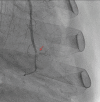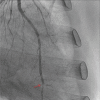A Rare Case of Coronary Artery Embolism in a Patient with d-Transposition of the Great Arteries with Prior Mustard Repair
- PMID: 29657908
- PMCID: PMC5896973
- DOI: 10.7759/cureus.2183
A Rare Case of Coronary Artery Embolism in a Patient with d-Transposition of the Great Arteries with Prior Mustard Repair
Abstract
The dextro-transposition of great arteries (d-TGA) is a rare, congenital, cyanotic heart disease and there is a paucity of data regarding long-term cardiovascular outcomes. We present a rare case of non-ST-elevation myocardial infarction (NSTEMI) in a patient with surgically repaired d-TGA. A 43-year-old male who had previously undergone a Mustard atrial switch palliative procedure presented with chest pain and diaphoresis and was diagnosed with NSTEMI. A coronary angiogram revealed a small, underdeveloped, left anterior descending and a large, left circumflex coronary artery with an acute embolic lesion. The embolic lesion was secondary to atrial fibrillation and was successfully treated with aspiration thrombectomy. This case highlights the variations in coronary anatomy in surgically repaired d-TGA and the importance of recognizing the potential for long-term complications in these cases.
Keywords: atrial fibrillation; mustard repair; transposition of the great arteries.
Conflict of interest statement
The authors have declared that no competing interests exist.
Figures





Similar articles
-
Paradoxical cerebral embolism three decades after mustard surgery in a patient with complete transposition of the great arteries: a case report.J Int Med Res. 2024 Oct;52(10):3000605241291753. doi: 10.1177/03000605241291753. J Int Med Res. 2024. PMID: 39474640 Free PMC article.
-
A Suspected Case of Acute Embolic Myocardial Infarction Following Direct-Current Cardioversion of Atrial Fibrillation.Am J Case Rep. 2018 Nov 2;19:1306-1310. doi: 10.12659/AJCR.911469. Am J Case Rep. 2018. PMID: 30385736 Free PMC article. Review.
-
Acute myocardial infarction in a patient with congenitally corrected transposition of the great arteries and complex coronary anatomy-a case report.Eur Heart J Case Rep. 2022 Nov 2;6(11):ytac423. doi: 10.1093/ehjcr/ytac423. eCollection 2022 Nov. Eur Heart J Case Rep. 2022. PMID: 36405539 Free PMC article.
-
Management of the Adult with Arterial Switch.Methodist Debakey Cardiovasc J. 2019 Apr-Jun;15(2):133-137. doi: 10.14797/mdcj-15-2-133. Methodist Debakey Cardiovasc J. 2019. PMID: 31384376 Free PMC article. Review.
-
Technique of Coronary Transfer for TGA with Single Coronary Artery.Korean J Thorac Cardiovasc Surg. 2014 Dec;47(6):529-32. doi: 10.5090/kjtcs.2014.47.6.529. Epub 2014 Dec 5. Korean J Thorac Cardiovasc Surg. 2014. PMID: 25551074 Free PMC article.
Cited by
-
A successful bridge to recovery with Impella 5.0 and subsequent hybrid cardiac resynchronization therapy in systemic right ventricle failure: a case report.Eur Heart J Case Rep. 2023 Apr 30;7(5):ytad214. doi: 10.1093/ehjcr/ytad214. eCollection 2023 May. Eur Heart J Case Rep. 2023. PMID: 37324501 Free PMC article.
References
-
- Improved national prevalence estimates for 18 selected major birth defects—United States, 1999-2001. MMWR Morbidity and mortality weekly report. Centers for Disease Control and Prevention. JAMA. 2006;54:1301–1305. - PubMed
-
- Evaluation and management of the adult patient with transposition of the great arteries following atrial-level (Senning or Mustard) repair. Love BA, Mehta D, Fuster VF. Nat Clin Pract Cardiovasc Med. 2008;5:454–467. - PubMed
-
- Twenty-five years' experience with the arterial switch operation. Hutter PA, Kreb DL, Mantel SF, Hitchcock JF, Meijboom EJ, Bennink GB. J Thorac Cardiovasc Surg. 2002;124:790–797. - PubMed
-
- Congenitally corrected transposition of the great arteries. Hornung TS, Calder L. Heart. 2010;96:1154–1161. - PubMed
Publication types
LinkOut - more resources
Full Text Sources
Other Literature Sources
